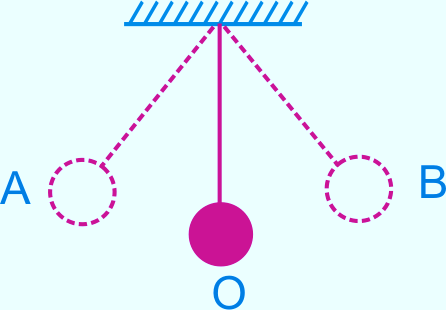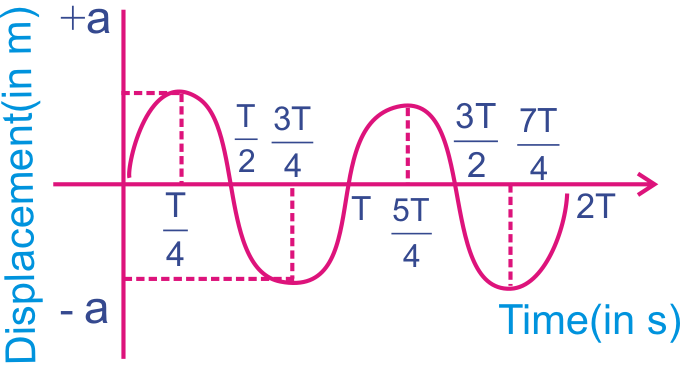In physics, a wave is a disturbance (an oscillation) that travels through space as time passes. It is accompanied by transfer of energy.
When a pebble is thrown into still water circular ripples are formed which spread out in all directions on the surface of water from the point where the stone hit the water surface. Thus, the kinetic energy of the stone is transferred to the water and that energy is distributed to the entire water in the pond in the form of ripples or waves. To check whether water moves along with ripples produced or not, we can observe a floating object like cork or a leaf placed on the surface of water. As the ripple move in all possible direction on the surface of water from the point where the disturbance is produced, the leaf which is floating on the surface of water vibrates up and down, but does not have lateral translatory motion along the surface of water.
We even observe that the leaf does not start vibrating till the first ripple reaches it from the point of disturbance. This is the characteristic of the propagation of waves.
Also Check: Force
The energy is transmitted from one point to another without actual translator motion or transport of the particles across the medium. Thus a “wave is a disturbance produced at a point in a medium or a field and is transmitted to other parts of the medium or the field without the actual translatory motion of the particles” The transfer of energy in the form of waves is known as “wave motion”.
SIMPLE PENDULUM
A simple pendulum consists of a particle of mass m, usually called the bob, suspended from a rigid support with the help of an unstretchable, mass less string.

A practical simple pendulum has small metallic bob suspended from an unstrechable thread and its length ‘l’ is the distance between the point of suspension and the centre of gravity of the bob.

A, B, extreme positions, O mean position
When a simple pendulum is set to oscillate it moves to and fro about its mean position between the two extremes A and B with constant amplitude as shown in the figure.
When we plot the horizontal displacement and the time on a graph paper the curve obtained would be in the form of a wave.
Each loop of the graph represents one complete oscillation of the pendulum. When the bob is at its mean position the displacement is zero and at its extremes the displacement is either ‘+a’ or ‘-a’ corresponding to the amplitude of the oscillation.

Oscillation
Oscillation is the repetitive motion performed about a central point called as mean position.

Example: pendulum of wall clock oscillating about the lower most point.
Vibration
The to and fro or back and forth motion of an object is called vibration
Also Check: Frictional Force
WAVES
A wave can be described as disturbances that travel though a medium from location to another.
Classification of Waves
Wave can be classified on the basis of medium of propagation and nature of propagation.
Some wave requires medium to propagate whereas some propagate without any medium i.e. in vacuum as well. Vacuum is medium with no matter. It is also referred as no medium.
CLASSIFICATION ON THE BASIS OF MEDIUM OF PROPAGATION
- Mechanical Waves: The waves which require medium for their propagation are called mechanical waves or elastic waves. For example: waves in stretched string or water waves.
- Non Mechanical Waves: The waves which do not require medium for their propagation are called non-mechanical waves. For example: Light and radio waves, -rays, X-rays etc, are common examples of such waves.
Now we can further classify waves in two parts on the basis of particle and wave motion.
CLASSIFICATION ON THE BASIS OF NATURE OF PROPAGATION
- Transverse Waves: If the particles of medium vibrate about their mean position in a direction perpendicular to the direction of wave propagation, wave is called transverse wave. For example: wave produced in string is transverse in nature.

It propagates in the form of crests and troughs. The particles having maximum upward displacement are called crests and particle having maximum downward displacement are called troughs. All electromagnetic waves e.g. light and radio waves are transverse in nature.
- Longitudinal Waves: If the particles of medium vibrate about their mean positions in the direction of wave propagation, the wave is called longitudinal waves. These are propagated in the form of compression and rarefaction and also known as pressure or compression waves. Waves on spring and sound waves in air are common examples of longitudinal waves.

A compression is that part of a longitudinal wave in which the particles of the medium are closer to one another than they normally are, and there is a momentary reduction in volume of the medium. We will see further analysis while studying sound because sound wave is a longitudinal wave.
Also Check: Buoyant Force
TERMS RELATED TO WAVE MOTION
The snap shot (photograph of an instant) of a transverse wave can be represented as shown in the figure

- Crest: It is the point of maximum displacement of a particle in upward direction.
- Trough: It is the point of maximum displacement of a particle in downward direction.
- Amplitude: It is the maximum displacement of the particles either upwards or downwards.
- Wavelength (l): It is the distance between any two successive crests or troughs.
- Wave number: It is the reciprocal of wavelength
- Time period (T): It is the time required for one oscillation.
- Frequency (n): It is the number of oscillation or vibration made by a particle in one second..
n = 1/T
The S.I. unit of frequency is hertz (Hz)
1 hertz = 1 s-1
Velocity of a wave (v): It is the speed with which the wave propagates in the medium.
Frequency = Wavlength / Time
Also Check: Thrust & Pressure
Ques: A simple pendulum completes 10 oscillations in 20 sec. Find its time period and frequency.
Solution: The time period is the time taken to complete one oscillation.
Hence time period T = 20 / 10 = 2 sec
and frequency f = 1 /T = 05 Hz
Ques: The distance between 1st compression and the rarefaction next to 2nd compression in a longitudinal wave is 15 m. If the frequency of the wave is 200 Hz then find the speed of wave.
Solution: Distance between two consecutive compression or rarefaction is l and the distance between neighboring compression and rarefaction is l/2
Therefore,

Frequently Asked Questions
A wave is a disturbance that moves through a medium, carrying energy without moving the medium itself. It can be a change in shape, pressure, electric or magnetic fields, or temperature.
Frequency is how often a wave passes a certain point in a specific amount of time. We measure frequency in hertz (Hz), which means one wave per second.
Amplitude is the height of a wave from its middle position to its highest point. It shows how much energy the wave carries. A bigger amplitude means more energy.
Electromagnetic waves are waves that can travel through space without needing a medium (like air or water) to move through. They're created by changes in electric and magnetic fields.
Examples of electromagnetic waves include radio waves (used for radio signals), light (which we see), x-rays (used in medical imaging), and cosmic rays (from outer space).
Related Links
| S.no | Formulas List |
|---|---|
| 1. | Force |
| 2. | Frictional Force |
| 3. | Thrust and Pressure |
| 4. | Buoyant Force |
| 5. | Waves |
| 6. | Sound |
| 7. | Some Natural Phenomena |
| 8. | Electroscope |
| 9. | Lightning |
| 10. | Earthquake |